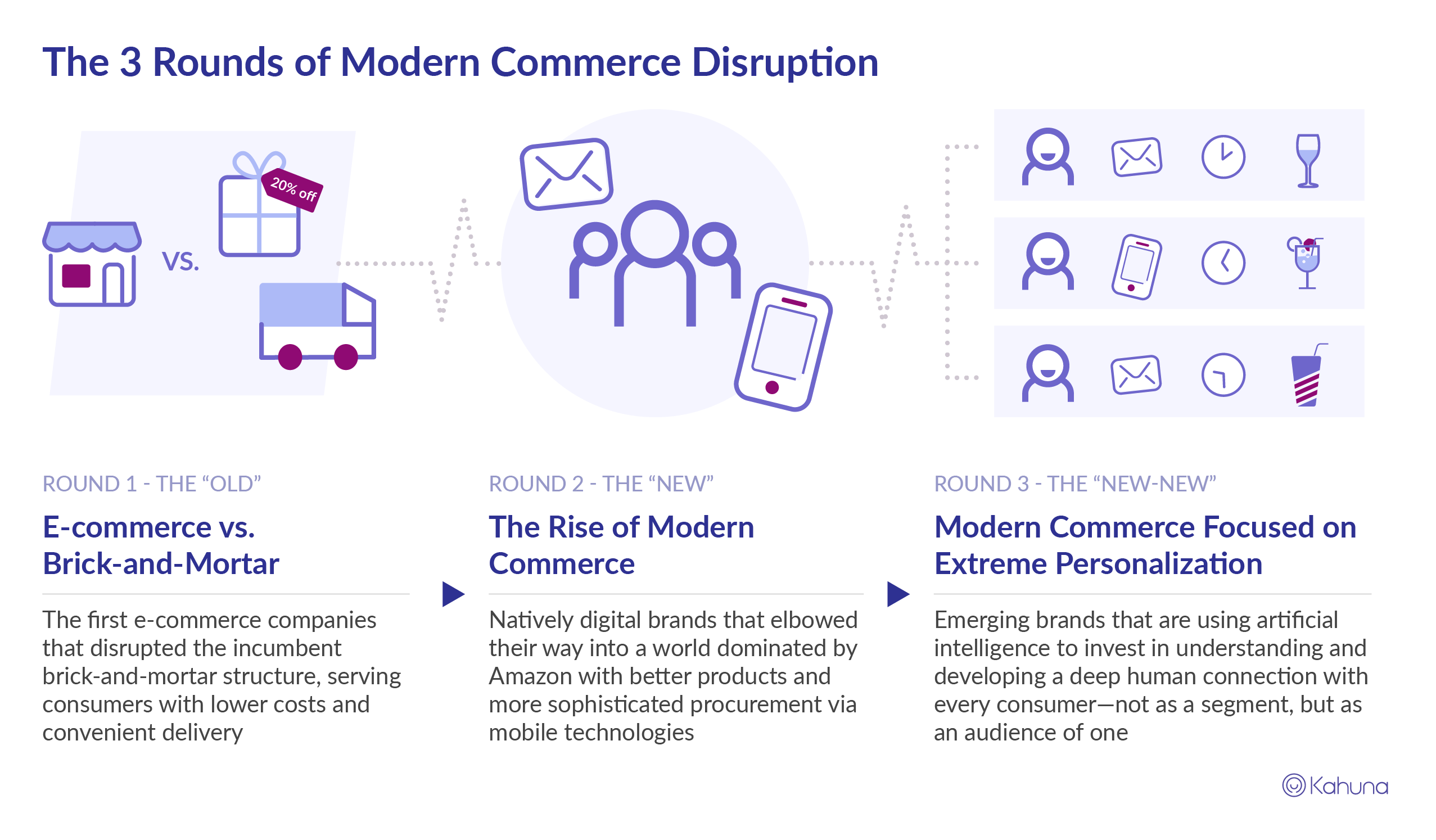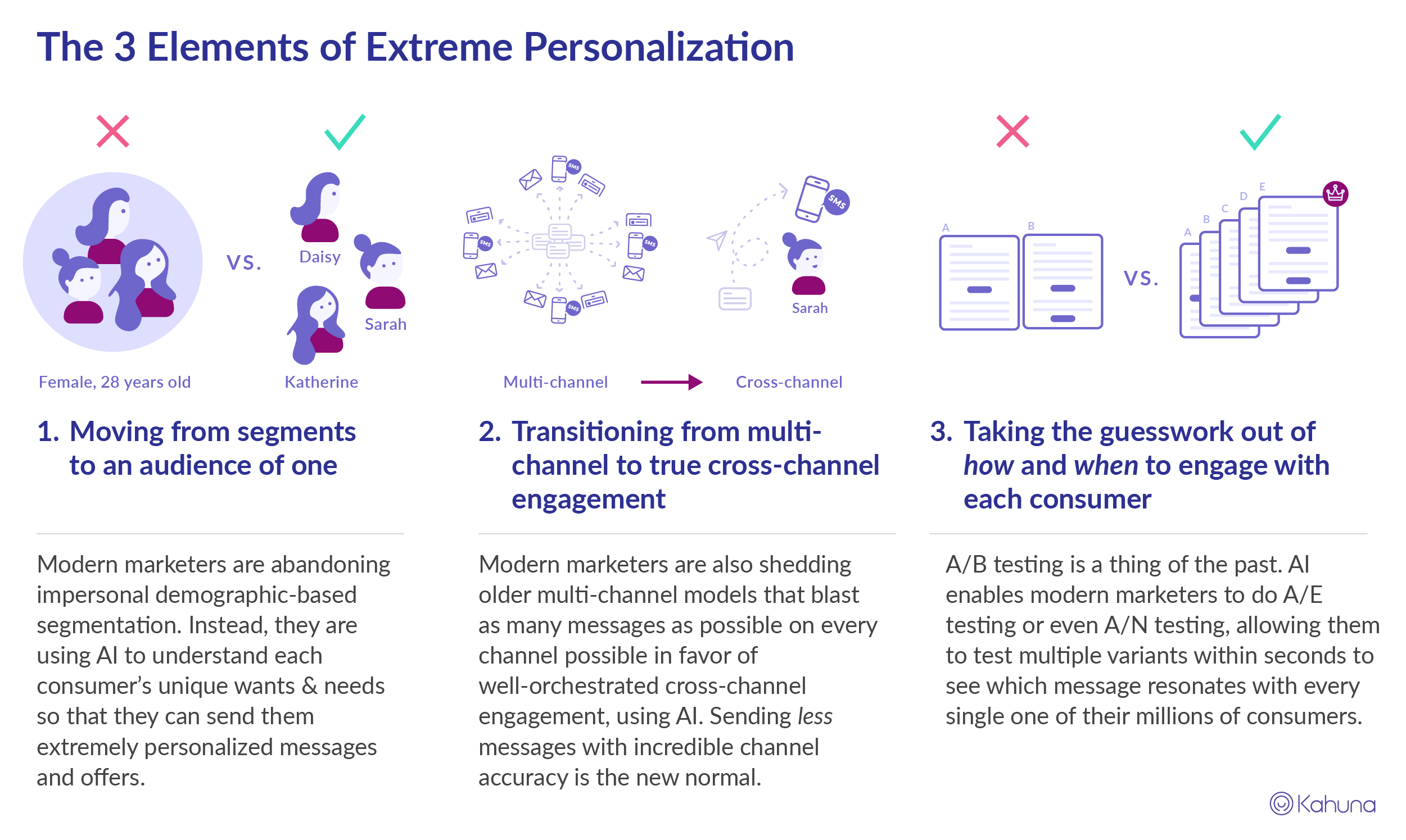Retails last resort? Extreme Personalization. #AI #CRM #ecommerce

 The battle for digital commerce domination just heated up. Again. Amazon enters the brick and mortar grocery business. Walmart enters high-end fashion with the purchase of Bonobos. Nike and Sears cave in and agree to sell their products on Amazon. And finally, Amazon takes on Black Friday with Prime Day, raking in a whopping $3 billion in a single day. And all that is in just the first half of 2017.
The battle for digital commerce domination just heated up. Again. Amazon enters the brick and mortar grocery business. Walmart enters high-end fashion with the purchase of Bonobos. Nike and Sears cave in and agree to sell their products on Amazon. And finally, Amazon takes on Black Friday with Prime Day, raking in a whopping $3 billion in a single day. And all that is in just the first half of 2017.
There is one common thread between all these bold moves. This time it isn’t just about obliterating brick and mortar businesses with a lower cost model, or even with better products a la Uber. The new crop of winners in commerce are working hard to become experts not only in operational efficiency, or in the product category they want to dominate. They are working just as hard to become experts in every single consumer’s current and emerging needs. And to do that, they will have re-wired the experience to achieve extreme personalization. Every consumer wants to feel like she is the only buyer on the digital shopping floor. Every consumer now wants to be treated as an audience of one.
The 3 evolutionary phases of modern commerce
To truly understand the enormity of this shift and both the problem and the gigantic opportunity for digital commerce providers, it’s important to step back and frame the 3 evolutionary phases of modern commerce.
 Round 1 centered on disrupting incumbents with better distribution and fulfillment unit cost economics and as a result, we saw trillions in commerce move from bricks to clicks. Think Amazon. You get my drift.
Round 1 centered on disrupting incumbents with better distribution and fulfillment unit cost economics and as a result, we saw trillions in commerce move from bricks to clicks. Think Amazon. You get my drift.
Round 2 centered on new upstarts successfully elbowing their way into the market with better products and better customer experience, largely capitalizing on two factors:
- Where its predecessors provided better distribution economics, digital-first upstarts re-thought every element of the demand and supply chain to create a superior customer experience with respect to both the product and the purchase journey. They went after business models laden with layers of bureaucratic fat and unnecessary cost, what I refer to as the Dollar Shave Club of everything, and provided a more modern, convenient and sometimes cheaper alternative.
- By capitalizing on the explosion of mobile devices, these brands engage the consumer using a multi-channel approach—email, web, and mobile.
As a result, hundreds of billions of dollars worth of online commerce was generated. And iconic brands we know and love, emerged: Bonobos, Revolve Clothing, Jet.com and hundreds of others selling everything from artistic book binders to haute couture.
Surprising as it might seem Round 1 and Round 2 still ended up leaving significant inefficiencies: Brands are still batching and blasting emails in the hopes that they will make it up in the numbers. Mobile, Email, Web and offline presence are treated as disconnected channels resulting in the left hand not knowing what the right hand is doing. And so in spite of a genuine attempt to improve consumer experience, the results speak for themselves:
- 91% of us unsubscribe from emails (Salesforce)
- 44% of direct mail is never opened (NewsCred)
- 60% of us opt out of mobile push notifications (Kahuna)
- Over $280 billion is abandoned in digital shopping carts, every year (Google)
Round 3, in the form of Extreme Personalization, is now upon us
With all the cost inefficiency sucked out of the demand and supply chain and with a plethora of engagement channels available to target the customer, disruption this time around is driven by a single notion: extreme personalization.
Extreme Personalization, powered by artificial intelligence (AI), begins to re-frame the mechanics of consumer engagement and is characterized by the following 3 elements:
- Moving from segments to an audience of one. The top 1% of your customers are worth 18x more than the average customer (RJ Metrics). Do you really think segmenting them with the rest is the way to go? Modern brands are adding real-time marketing technology to their existing marketing automation stach to understand individual preferences literally within seconds and using this insight to better engage the 1% and to make every consumer 18x more valuable.
- Transitioning from multi-channel to truly cross-channel engagement. Modern marketers aim to send less messages, not more. That’s how you respect the consumer and why she comes back time and time again. Today’s consumer expects that you consume the digital bread crumbs she opted in to leave behind, and then let the machines help sort out just the right message on the right channel and on the right path and pace of conversion. As an example, optimizing just the timing of the message using AI resulted in TickPick, a leading events marketplace, realizing a 44% increase in sign ups and a whopping 29% increase in ticket sales.
- Taking the guesswork out of when and how you engage with the customer. A/B testing is a thing of the past. Modern marketers now do A/E testing or even A/N testing, using systems that allow them to test multiple variants within seconds to see which message resonates with each one of their million consumers.
The good news is that moving to this new model of extreme personalization isn’t as daunting as it might seem. The artificial intelligence technology that can power the right decisioning about how to improve your relationship with every consumer does not require a big, risky rip and replace project. Rather, it can plug right into your existing marketing automation and e-commerce technology stack to deliver value within weeks.
Round 3 isn’t an evolution; it’s whole-scale re-arranging of commerce that’s driven not just by good product or best price but by also by customer experience. Every digital commerce vendor, both old and new needs to become the expert not just in a product or a service, but in the consumer.
And what perhaps makes this irrefutably evident is how the goliaths of commerce are not resting on their laurels and are reloading for this new paradigm of extreme personalization using AI. Jeff Bezos devoted his recent shareholder letter to four topics and one of them was the use of machine learning and AI. As Bezos points out in the letter:
“Much of what we do with machine learning happens beneath the surface. Machine learning drives our algorithms for demand forecasting, product search ranking, product and deals recommendations, merchandising placements, fraud detection, translations, and much more.”
And as a result…
“It’s a virtuous cycle that allows Amazon to highly personalize its offerings, better predict what consumers want next, and pursue innovations at high velocity. All of this translates into competitive advantage for the ecommerce giant.”
The cheese has moved. The machines are here. And they’re teaching every commerce provider and retailer to become very smart about every single consumer.
Game on.
